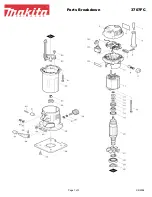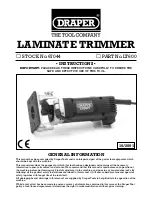
EnGLIsH • 23
charger diagnostics
This charger is designed to detect certain problems that can
arise with the battery packs or the power source. Problems
are indicated by one LED flashing in different patterns.
Bad Battery
The charger can detect a weak or damaged
battery. The red LED flashes in the pattern
indicated on the label. If you see this bad
battery blink pattern, do not continue to charge the battery.
Return it to a service center or a collection site for recycling.
Hot/cold Pack delay
When the charger detects a battery that is
excessively hot or excessively cold, it automatically
starts a Hot/Cold Pack Delay, suspending charging until
the battery has normalized. After this happens, the charger
automatically switches to the Pack Charging mode. This feature
ensures maximum battery life. The red LED flashes in the pattern
indicated on the label when the hot/cold pack delay is detected.
Leaving the Battery in the charger
The charger and battery pack can be left connected with the
green LED glowing indefinitely. The charger will keep the
battery pack fresh and fully charged.
Important charging notes
1. Longest life and best performance can be obtained if
the battery pack is charged when the air temperature is
between 60°F and 80°F (16°- 27°C). DO NOT charge
the battery pack in an air temperature below +40°F
(+4.5°C), or above +105°F (+40.5°C). This is important
and will prevent serious damage to the battery pack.
2. The charger and battery pack may become warm to
touch while charging. This is a normal condition, and
does not indicate a problem. To facilitate the cooling of
the battery pack after use, avoid placing the charger or
battery pack in a warm environment such as in a metal
shed, or an uninsulated trailer.
3. If the battery pack does not charge properly:
a. Check current at receptacle by plugging in a lamp or
other appliance.
b. Check to see if receptacle is connected to a light
switch which turns power off when you turn out the
lights.
c. Move charger and battery pack to a location where
the surrounding air temperature is approximately
60°F - 80°F (16° - 27°C).
d. If charging problems persist, take the tool, battery
pack and charger to your local service center.
4. The battery pack should be recharged when it fails to
produce sufficient power on jobs which were easily
done previously. DO NOT CONTINUE to use under
these conditions. Follow the charging procedure. You
may also charge a partially used pack whenever you
desire with no adverse affect on the battery pack.
5. Foreign materials of a conductive nature such as, but
not limited to, steel wool, aluminum foil, or any buildup
of metallic particles should be kept away from charger
cavities. Always unplug the charger from the power
supply when there is no battery pack in the cavity.
Unplug charger before attempting to clean.
6. Do not freeze or immerse charger in water or any
other liquid.
Warning! Shock hazard. Do not allow any liquid to get
inside charger. Never attempt to open the battery pack for
any reason. If the plastic housing of the battery pack breaks
or cracks, return to a service center for recycling.
Installing and removing the Battery Pack
Warning! Make certain the lock-off button is engaged to
prevent switch actuation before removing or installing battery.
To install battery pack: Insert battery pack into tool until
fully seated and an audible click is heard
(fig. C).
To remove battery pack: Depress the battery release button in
the back of the battery pack and pull battery pack out of tool.
AssEMBLY & AdJusTMEnT
Assembly Tools required (not supplied):
- Phillips Screwdriver
Installing the Guard
(fig. D and E)
Warning! remove the battery before attempting to
attach the guard, edge guide or handle. never operate
tool without guard firmly in place. The guard must
always be on the tool to protect the user.
f
f
Turn the trimmer upside down so that you are looking
down at the spool cap
(8).
f
f
Turn the guard
(7) upside down and slide it onto the
motor housing
(10). Make sure the tabs (11) on the guard
engage the ribs
(12) on the motor housing as shown.
f
f
Continue to slide the guard on until you hear it “snap”
into place.
f
f
Using a phillips screwdriver, insert the guard screw as
shown in
fig. E to complete the guard assembly.
f
f
Once the guard is installed, remove the covering from
the line cut-off blade, located on the edge of the guard.
Attaching the Auxiliary Handle (fig. F, G and H)
f
f
To attach the handle, press in on the buttons
(13) on
both sides of the upper housing as shown in
fig. F.
f
f
Position the handle as shown in
fig. G (with the Black
& Decker logo facing upward). Partially push the
handle on so that it will hold the buttons in when you
release them with your hand.
f
f
Push the handle completely onto the housing and
position it slightly until it “snaps” into place
(fig. H).
Содержание LST220FC
Страница 2: ...A d F B c E G 1 2 3 4 6 7 10 5 8 8 7 11 12 13 2 2 9 ...
Страница 3: ...H L o I K J M P 14 15 4 4 17 16 16 18 19 20 22 21 ...
Страница 4: ...Q r s 23 24 25 26 ...




































